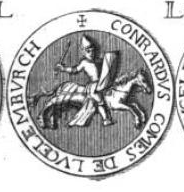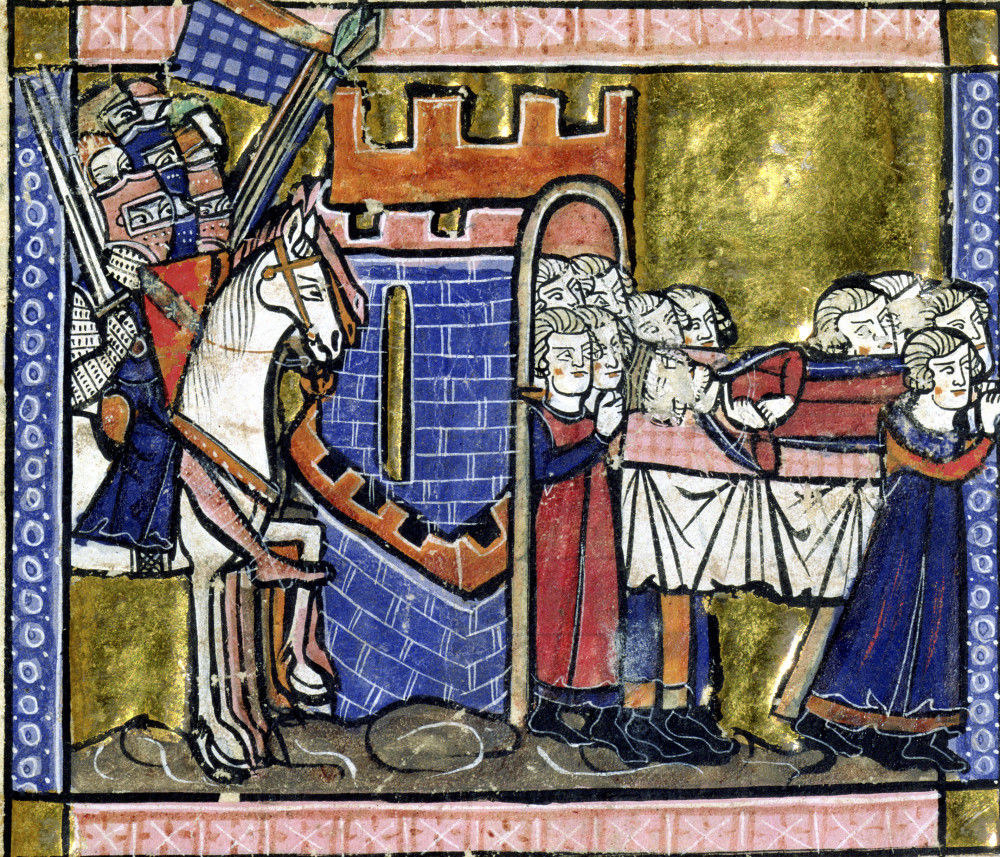|
William, Count Of Luxembourg
William I, Count of Luxembourg (1081–1131) was count of Luxembourg (1096–1131), in succession to his elder brother Henry III of Luxembourg. They were both sons of Conrad and Clementia of Aquitaine. William was the first of his family to use the title ''count of Luxembourg'' in his documents. Like his predecessors, he was embroiled in debates with the archbishop of Trier Bruno in 1122 and 1127, leading to William's excommunication. Around 1105 he married Mathilde or Luitgarde of Northeim, daughter of Kuno, count of Beichlingen, and had three children: * Conrad II Conrad II ( – 4 June 1039), also known as and , was the emperor of the Holy Roman Empire from 1027 until his death in 1039. The first of a succession of four Salian emperors, who reigned for one century until 1125, Conrad ruled the kingdoms ... († 1136), count of Luxembourg * William, count of Gleiberg, documented in 1131 and in 1158 * Liutgarde (* 1120 - † 1170), married Henri II (* 1125 - † 1211), cou ... [...More Info...] [...Related Items...] OR: [Wikipedia] [Google] [Baidu] |
Count Of Luxembourg
The territory of Luxembourg has been ruled successively by counts, dukes and grand dukes. It was part of the medieval Kingdom of Germany, and later the Holy Roman Empire until it became a sovereign state in 1815. Counts of Luxembourg House of Ardenne–Luxembourg House of Luxembourg–Namur House of Hohenstaufen House of Luxembourg–Namur House of Luxembourg–Limburg Dukes of Luxembourg In 1354 the county was elevated to a duchy. House of Luxembourg-Limburg As Elisabeth had no surviving children, she sold Luxembourg to Philip III, Duke of Burgundy in 1441 but only to succeed upon her death. Philip captured the city of Luxembourg in 1443, but did not assume the ducal title because of conflicting claims by Anne of Austria, the closest Luxembourg relative. Claimants House of Valois-Burgundy In 1467, when Elisabeth II of Austria, last rival claimant to the title, renounced her rights, Philip III's son, Charles, Duke of Burgundy, assumed the title of duke ... [...More Info...] [...Related Items...] OR: [Wikipedia] [Google] [Baidu] |
Henry III Of Luxembourg
Henri III, Count of Luxembourg (died 1096) was count of Luxembourg from 1086 until his death. He succeeded his father, Conrad I. His mother was Clementia of Aquitaine. Henry III was the first count known to have established his permanent residence in Luxembourg castle. In a document from the year 1089, he is referred to as comes Henricus de Lutzeleburg, which also makes him the first documented count of Luxembourg. He never married and was succeeded by his brother William William is a masculine given name of Norman French origin.Hanks, Hardcastle and Hodges, ''Oxford Dictionary of First Names'', Oxford University Press, 2nd edition, , p. 276. It became very popular in the English language after the Norman conq .... 1096 deaths Counts of Luxembourg Year of birth unknown House of Luxembourg {{Europe-noble-stub ... [...More Info...] [...Related Items...] OR: [Wikipedia] [Google] [Baidu] |
Conrad I Of Luxembourg
Conrad I (c. 1040 – 8 August 1086) was count of Luxembourg (1059–1086), succeeding his father Giselbert of Luxembourg. He was embroiled in an argument with the archbishop of Trier as to the abbaye Saint-Maximin in Trier which he had avowed. The archbishop excommunicated him and Conrad had to make honourable amends and set out on pilgrimage for Jerusalem to have his excommunication lifted. He died in Italy on the return journey. He founded the Orval Abbey in 1070 with Count Arnold I of Chiny and the Altmünster Abbey in 1083. Marriage and issue Around 1075 he married Clementia (1060–1142), daughter of Duke William VII of Aquitaine and of Ermesinde. They had: * Matilda (1070 † ), married Godefroy (1075 † ), Count of Bleisgau * Henry III († 1096), Count of Luxembourg * Rudolph († 1099), abbot of Saint-Vannes at Verdun * Conrad, cité en 1080 * Adalbero, (d. 1098 in Antioch), Archdeacon of Metz, travelled to the Holy Land as part of the army of Godfrey of Bouill ... [...More Info...] [...Related Items...] OR: [Wikipedia] [Google] [Baidu] |
Clementia Of Aquitaine
Clémence d'Aquitaine (1048, Poitiers, France – 4 January 1130) was the daughter of William VII, Duke of Aquitaine and Ermensinde de Longwy. Biography Around 1075 she married Conrad I, Count of Luxembourg and together they had: * Matilda; married Godefrey, Count of Bliesgau. * Henry III, Count of Luxembourg (1096†) * Rudolph (1099†); abbot of Saint-Vannes at Verdun. * Conrad * Adalbero (1098†); Archdeacon of Metz, was traveling to Jerusalem as part of the army of Godfrey of Bouillon, when he was executed by the Turks. * Ermesinde (1080-1143); married Albert II, count of Egisheim and of Dagsbourg; after his passing she married Godfrey I, Count of Namur. * William I (1081-1131); Count of Luxembourg. After Conrad's death in 1086, she later married Gerard I, Count of Guelders Gerard I, Count of Guelders (c. 1060 – 8 March 1129) was Count of Guelders (Gelre in Dutch). He was the son of Theodoric of Wassenberg. He may have been married to Clementia of Aquitaine, alt ... [...More Info...] [...Related Items...] OR: [Wikipedia] [Google] [Baidu] |
Archbishop Of Trier
The Diocese of Trier, in English historically also known as ''Treves'' (IPA "tɾivz") from French ''Trèves'', is a Latin Church ecclesiastical territory or diocese of the Catholic church in Germany."Diocese of Trier" '' Catholic-Hierarchy.org''. David M. Cheney. Retrieved February 29, 2016"Diocese of Trier" ''GCatholic.org''. Gabriel Chow. Retrieved February 29, 2016 When it was the archbishopric and Electorate of Trier, it was one of the most importan ... [...More Info...] [...Related Items...] OR: [Wikipedia] [Google] [Baidu] |
Conrad II Of Luxembourg
Conrad II of Luxembourg (died 1136) was count of Luxembourg (1131–1136), in succession to his father William, Count of Luxembourg. His mother was Mathilde or Luitgarde of Northeim. He married Ermengarde, daughter of count Otto II, Count of Zutphen. Conrad II died without a male heir, and so the county of Luxembourg reverted to the Holy Roman Emperor. The emperor in turn did not wish the county to be ruled by Conrad's closest relative Henri de Grandpré, who was a French lord and so might align the county with the kingdom of France The Kingdom of France ( fro, Reaume de France; frm, Royaulme de France; french: link=yes, Royaume de France) is the historiographical name or umbrella term given to various political entities of France in the medieval and early modern period ..., and so granted it to Henry of Namur, a cousin of Conrad's. 1136 deaths Counts of Luxembourg Year of birth unknown House of Luxembourg {{Luxembourg-bio-stub ... [...More Info...] [...Related Items...] OR: [Wikipedia] [Google] [Baidu] |
House Of Ardenne–Luxembourg
The House of Luxembourg (or Luxembourg), also known as the House of Ardenne–Luxembourg in order to distinguish it from later families, were a Lotharingian noble family known from the tenth and eleventh centuries. They are one of the three main branches of the House of Ardenne, along with the House of Ardenne–Verdun, and the House of Ardenne–Bar. All these Ardennes families descended from Cunigunda of France, a granddaughter of the West Frankish king Louis the Stammerer, and her husband Wigeric of Lotharingia. The Luxembourg branch descend from their son Sigfried, Count of the Ardennes. One continuing male-line branches of the House of Luxembourg include the House of Salm. The later House of Limburg, Dukes of Limbourg, whose descendants became Dukes of Luxembourg and a royal dynasty in Germany, descend from the House of Ardennes-Luxembourg through the daughter of Frederick, Duke of Lower Lorraine. Children of Count Sigfried: *Siegfried? cited in 985 ** Henry I of Lu ... [...More Info...] [...Related Items...] OR: [Wikipedia] [Google] [Baidu] |
Count Of Luxembourg
The territory of Luxembourg has been ruled successively by counts, dukes and grand dukes. It was part of the medieval Kingdom of Germany, and later the Holy Roman Empire until it became a sovereign state in 1815. Counts of Luxembourg House of Ardenne–Luxembourg House of Luxembourg–Namur House of Hohenstaufen House of Luxembourg–Namur House of Luxembourg–Limburg Dukes of Luxembourg In 1354 the county was elevated to a duchy. House of Luxembourg-Limburg As Elisabeth had no surviving children, she sold Luxembourg to Philip III, Duke of Burgundy in 1441 but only to succeed upon her death. Philip captured the city of Luxembourg in 1443, but did not assume the ducal title because of conflicting claims by Anne of Austria, the closest Luxembourg relative. Claimants House of Valois-Burgundy In 1467, when Elisabeth II of Austria, last rival claimant to the title, renounced her rights, Philip III's son, Charles, Duke of Burgundy, assumed the title of duke ... [...More Info...] [...Related Items...] OR: [Wikipedia] [Google] [Baidu] |
Henry III, Count Of Luxembourg
Henri III, Count of Luxembourg (died 1096) was count of Luxembourg from 1086 until his death. He succeeded his father, Conrad I. His mother was Clementia of Aquitaine. Henry III was the first count known to have established his permanent residence in Luxembourg castle. In a document from the year 1089, he is referred to as comes Henricus de Lutzeleburg, which also makes him the first documented count of Luxembourg. He never married and was succeeded by his brother William William is a masculine given name of Norman French origin.Hanks, Hardcastle and Hodges, ''Oxford Dictionary of First Names'', Oxford University Press, 2nd edition, , p. 276. It became very popular in the English language after the Norman conq .... 1096 deaths Counts of Luxembourg Year of birth unknown House of Luxembourg {{Europe-noble-stub ... [...More Info...] [...Related Items...] OR: [Wikipedia] [Google] [Baidu] |
1081 Births
1 (one, unit, unity) is a number representing a single or the only entity. 1 is also a numerical digit and represents a single unit of counting or measurement. For example, a line segment of ''unit length'' is a line segment of length 1. In conventions of sign where zero is considered neither positive nor negative, 1 is the first and smallest positive integer. It is also sometimes considered the first of the infinite sequence of natural numbers, followed by 2, although by other definitions 1 is the second natural number, following 0. The fundamental mathematical property of 1 is to be a multiplicative identity, meaning that any number multiplied by 1 equals the same number. Most if not all properties of 1 can be deduced from this. In advanced mathematics, a multiplicative identity is often denoted 1, even if it is not a number. 1 is by convention not considered a prime number; this was not universally accepted until the mid-20th century. Additionally, 1 is the ... [...More Info...] [...Related Items...] OR: [Wikipedia] [Google] [Baidu] |
1131 Deaths
Year 1131 ( MCXXXI) was a common year starting on Thursday (link will display the full calendar) of the Julian calendar. Events By place Levant * August 21 – King Baldwin II falls seriously ill, after his return from Antioch. He is moved to the patriarch's residence near the Holy Sepulchre, where he bequeaths the kingdom to his daughter Melisende, her husband Fulk and their infant son, Baldwin. He takes monastic vows, and dies soon after. Baldwin is buried in the Church of the Holy Sepulchre, at Jerusalem.Steven Runciman (1952). ''A History of The Crusades. Vol II: The Kingdom of Jerusalem'', pp. 148–149. . * September 14 – Melisende succeeds her father Baldwin II to the throne, and reigns jointly with Fulk, as King and Queen of Jerusalem. Their coronation, in the Church of the Holy Sepulchre, is celebrated with festivities. Europe * Ramon Berenguer III (the Great), count of Barcelona, dies after a 34-year reign. He leaves most of his Catalonian t ... [...More Info...] [...Related Items...] OR: [Wikipedia] [Google] [Baidu] |






